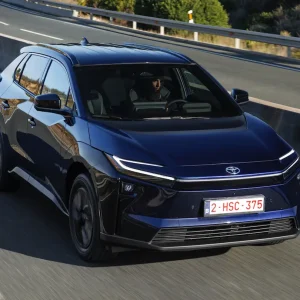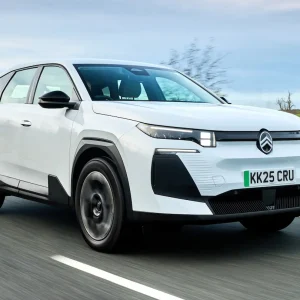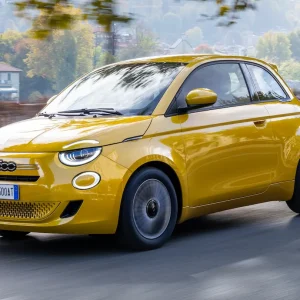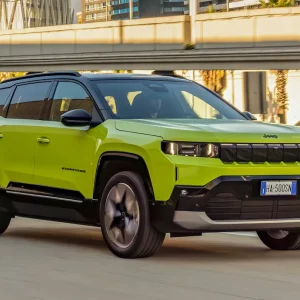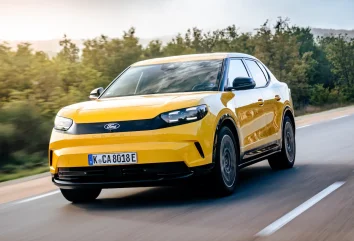
First things first: the new Capri has very little to do with the old one first sold in 1969 as a swaggering long-nosed, affordable two-door fastback coupé and last sold in 1986 with pretty much the same silhouette, attitude and mainstream male customer base.
The all-electric 2024 Capri has no need for a long nose to house a combustion engine and has a closer side profile connection to the Polestar 2. The Capri is actually 28mm longer than the premium Swedish newcomer (4634 vs. 4606), 13mm wider (1872 vs. 1859) and a significant 147mm taller (1626 vs. 1479) with a 32mm longer wheelbase (2767 vs. 2735mm). The Capri also sits on a borrowed VW electric MEB platform, although mercifully contains more design interest than the ID.4 or ID.5.
Design and interior
Ford’s designers are at pains to point out details that the new Capri shares with the old models – from the rounded rear side window line, to the vaguely dog bone-shaped front face and even the metal steering wheel spoke at six o’clock with drilled out holes – but the new five-door crossover does not have enough visual, or even proportional resonance with the Capri models that preceded it, to share the name in any meaningful way.
That said, the new design is well-executed and coherent, especially when viewed up close. Panel gaps are tight and minimal, and where different materials converge the results are usually flush and neat. You won’t see a bunch of sensors and other asymmetric safety addenda protruding from its front face either. They’re carefully hidden behind smooth and logical surfacing to the benefit of EV aerodynamics and range.
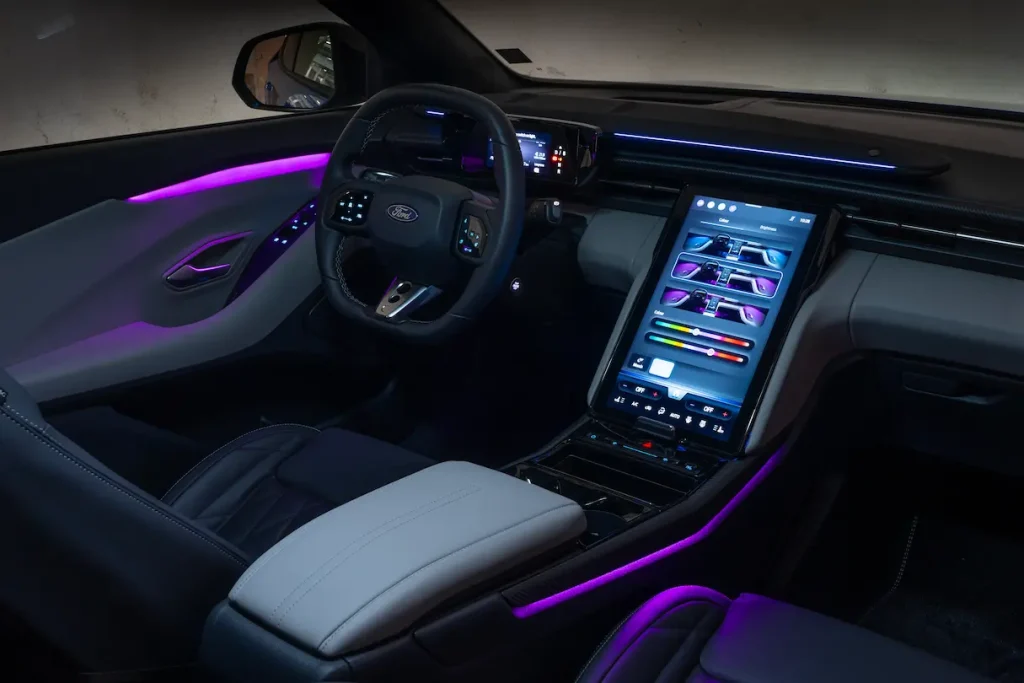
The Capri’s cabin shares the somewhat minimalist aesthetic of the new Explorer, as well as its secret locker space protected by the clever portrait-shaped and slidable centre touchscreen. There’s also a 17-litre central space below the front armrest for large handbags or perhaps a very masculine ‘man-bag’ with a gold chain. Passenger space for knees and heads sitting in the back is genuinely good and the boot is a sizeable 572 litres with rear seats up, rising to 1505 litres with rear seats folded.
On the road
Ford has a recent history as a maker of great cars to drive – from Fiesta to Focus – although ironically not so much with most of the old Capris, despite their sporty appearance. And the new electric Capri follows ‘old Capri’ rather than more recent Fords in this respect. On twisty roads at higher speeds, this higher-sided vehicle does not feel fully at ease.
With only a single-speed automatic transmission and no paddle-style regenerative braking options, the car can feel like it’s running away with itself a little too often. Indeed, the only regen option on the Capri comes from a twist of the steering column-mounted gear selector to the ‘B’ setting, which ‘holds’ the car after bursts of acceleration a bit more. But even when Sport mode is optioned – a two-stage touchscreen button press process rather than a quicker to access, physical interior switch or toggle – the driving experience doesn’t change tangibly. Ford’s engineers claim Sport mode sharpens the throttle response and steering feedback but it’s subtle at best.
Talking at the launch with the engineers, there seemed to be a sense that having to borrow the platform from VW put significant restraints on making the new Capri more Ford-like in the handling stakes. One thing the Ford engineers did stress, though, was that ride quality for long trips – especially for those in the back – had been really worked on, suggesting the new five-door Capri is aimed more at families than the old two-door coupé ever was.
The launch line-up starts with a 170hp RWD 52kWh Standard Range model in Select spec, good for 242 miles at £42,075, rising up to £56,175 for the range-topping 340hp AWD 79kWh Extended Range model in Premium spec, which has a WLTP range of 346 miles. The best performing model from an electric range perspective is the 389-mile 286hp RWD 77kWh Select version for £48,075.
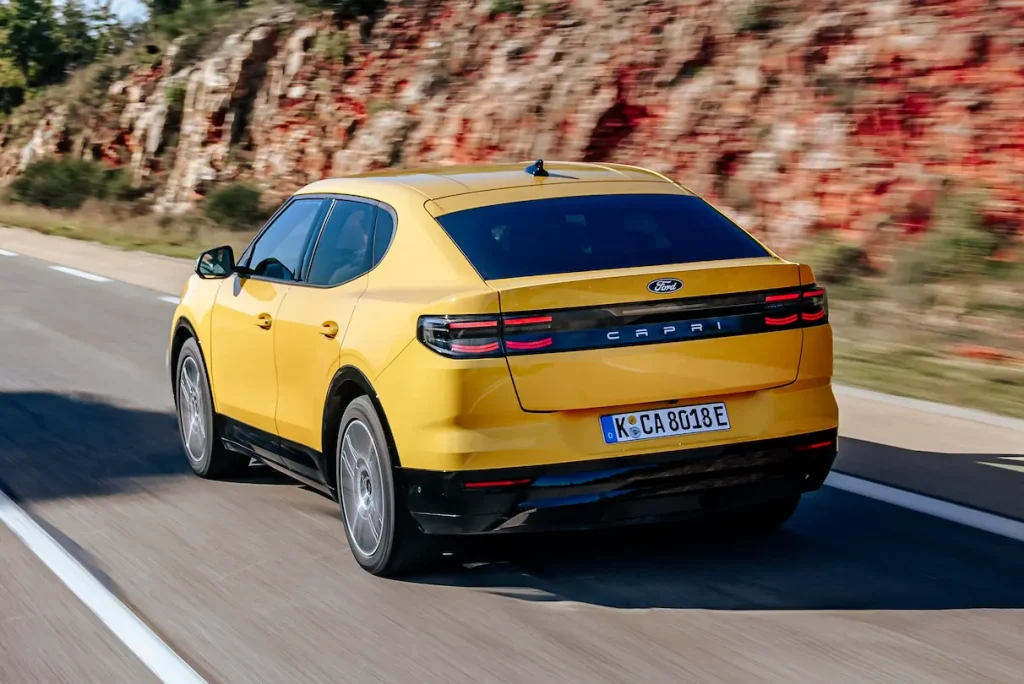
Standard kit on the Capri is fine, from both a safety and tech perspective. Wireless Apple and Android pairing is easy enough and via Ford’s own software certain annoying safety bleeps can be turned off on a screen two digital layers below the home page. In summary, the new Capri is decent enough to look at and to drive, but it doesn’t feel ‘stand-out’ in any respect. If you want a more sporty and desirable Ford EV, perhaps wait for the widely rumoured ST version to follow after initial deliveries in spring 2025.
Positive: Historic name, well-executed design
Negative: Name relevance now, lack of stand-out design or drive
Standard equipment: Blind spot info system, clear exit warning, cross traffic alert with active braking, evasive steering assist, lane departure warning, traffic sign recognition, front and rear park sensors, rear-view camera, independent adaptive cruise control, two-zone climate control, 5in digital instrument cluster and 14.6in adjustable central touchscreen, Bluetooth wireless Apple and Android mirror screening, heated steering wheel & front seats with massage, keyless entry and start, 19” alloys, wireless smartphone charging pad
Engines: Electric: 170hp, 286hp, 340hp
Equipment grades: Select, Premium
Transmissions: Single-speed automatic
| Model | Ford Capri Premium RWD 77kWh Extended Range |
| P11D | £52,120 |
| On sale | Late 2024 |
| Residual value | TBC |
| Depreciation | TBC |
| Fuel | TBC |
| Service, maintenance and repair | TBC |
| Cost per mile | TBC |
| Range | 369 miles |
| CO2 (BIK%) | 0g/km (2%) |
| BIK 20/40% a month | £17/£35 |
| Luggage capacity | 572 litres |
| Battery size/power | 77kWh/286hp |
| Score | 7/10 |

